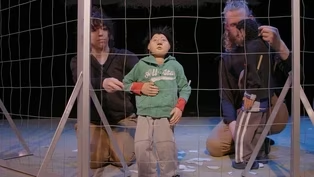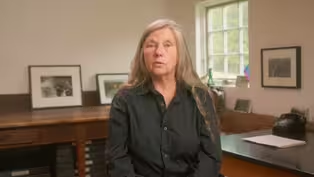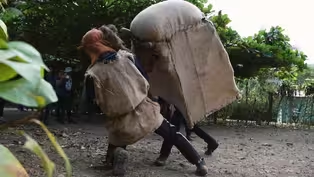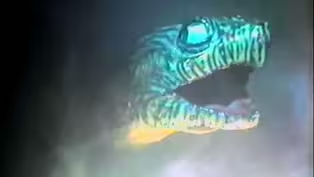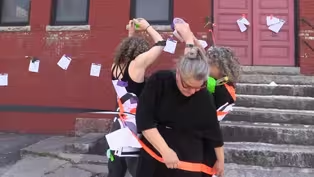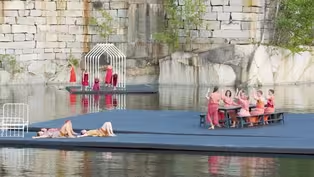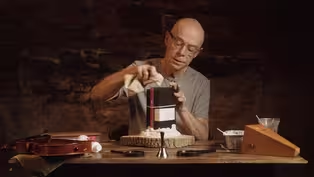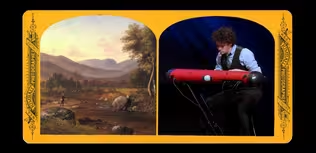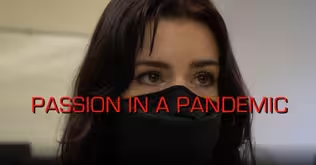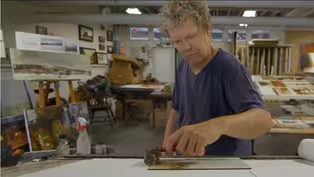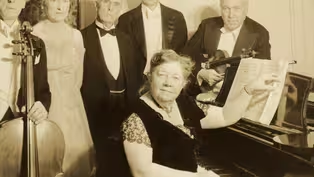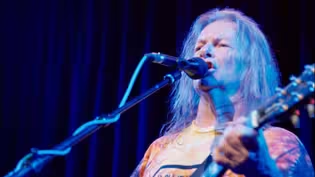Made Here
A Handmade Life
Season 22 Episode 10 | 57m 11sVideo has Closed Captions
Follow the journeys of 10 artists from New England each working in different mediums.
A Handmade Life shares the stories of ten artists from New England each working in different mediums. Their stories impart inspiration to continue these crafts and traditions for generations to come.
Problems playing video? | Closed Captioning Feedback
Problems playing video? | Closed Captioning Feedback
Made Here is a local public television program presented by Vermont Public
Sponsored in part by the John M. Bissell Foundation, Inc. and the Vermont Arts Council| Learn about the Made Here Fund
Made Here
A Handmade Life
Season 22 Episode 10 | 57m 11sVideo has Closed Captions
A Handmade Life shares the stories of ten artists from New England each working in different mediums. Their stories impart inspiration to continue these crafts and traditions for generations to come.
Problems playing video? | Closed Captioning Feedback
How to Watch Made Here
Made Here is available to stream on pbs.org and the free PBS App, available on iPhone, Apple TV, Android TV, Android smartphones, Amazon Fire TV, Amazon Fire Tablet, Roku, Samsung Smart TV, and Vizio.
Providing Support for PBS.org
Learn Moreabout PBS online sponsorshipMore from This Collection
Discover films showcasing cultural heritage and the arts.
Video has Closed Captions
BABYLON evokes refugee storytelling through puppet, actors and song. (1h 3m)
Video has Closed Captions
A short documentary on Sandgate, Vermont based photographer Donn Ann McAdams (12m 35s)
Video has Closed Captions
In a small jungle town an annual celebration occurs that contradicts the history books. (16m 50s)
Snapper: The Man-Eating Turtle Movie That Never Got Made
Video has Closed Captions
An unfinished early film about a man eating turtle in New England. (30m 38s)
Video has Closed Captions
A new experimental documentary film project from Vermont artist/filmmaker Christopher Wiersema (29m 59s)
Video has Closed Captions
An evocative dance film set in Vermont, in one of the oldest granite quarries in the world. (39m 50s)
Video has Closed Captions
Experimental short film inspired by 1960s Fluxus-era artists. (15m 27s)
A Journey to the White Mountains in Words and Music
Video has Closed Captions
Explore how 19th-century painters changed the way we view the White Mountains. (27m 42s)
Passion in a Pandemic: Making Opera at Hanover High School
Video has Closed Captions
An opera singer and a celebrated conductor coach high school students in opera performance (58m 4s)
Video has Closed Captions
Meet Charlie Hunter, an irascible and charismatic painter from Bellows Falls, Vermont. (27m 52s)
Video has Closed Captions
A documentary about the life and music of New Hampshire born composer Amy Beach. (58m 39s)
Video has Closed Captions
A day in the life of J. Willis Pratt and his fight with cancer. (29m 16s)
Providing Support for PBS.org
Learn Moreabout PBS online sponsorship-Hi, I'm -Eric Ford for Made Here.
-Director -Ian Scura from Concord, -New Hampshire, shares -the stories of ten artists -!from New England, each working -in different mediums -in the film A Handmade Life.
-Their stories provide -the inspiration to continue -these crafts and traditions -for generations to come.
-You can watch a handmade Life -and other great Made Here -!films streaming on our website -and through the PBS app.
-Enjoy the -film and thanks for watching.
-[leaves rustling in wind] -[leaves rustling in wind] -[birds chirping] -[wind chime rings] -[waves crash] -[seagulls calling] Come on guys.
[keys jingling] [doors open] Cmon guys!
Up, lets go!
-[paws patter on floor] -[footsteps] -[footsteps] -[light switch flicks] -[door creaks] -[switch flicks] -[pencil scribbling] -[sewing machine whirs] -♪♪ -Now, my dogs -have just said, Where's mom?
What did I do?
-♪♪ -I'm Donna Zils Banfield.
-I'm a wood artist.
-My name is Richard Roth, -and Woods and Water -Pottery is my company name.
-Hi, I'm Robert Burch.
-This is my daughter, Kate.
-I'm a glassblower.
My name is Caitlin Burch.
-I am a second generation -glassblower -and a self-taught lampworker.
-Hi, my name is Caleb White.
-!I am a professional knife maker.
-I'm Vicky Elbroch.
-We've lived here 17 years.
-I'm Lawrence Elbroch.
I go by Larry.
We happen to live together, so my name is Alan Carruth.
I am a luthier.
-A man who makes stringed -musical instruments.
-My name is Kate Kilgus, -and today we are in my home -workshop.
-I'm Sharon Dugan, -!and I make ash splint baskets.
-I've been making ash splint -baskets for 37 years.
-I love New -Hampshire, I love the trees.
-And this -is where I've always dreamt- -This is the life -!that I always dreamt of having.
-And I'm very happy.
-[wind chimes ring] -Sam comes from Apple Creek, -Ohio.
Oh wow.
Yeah.
-Sam and friends.
You can come back -they're not going to -do anything.
-I've always been a farmer -at heart.
-I'm happy -when my toes are in the dirt.
-We have a garden and guinea -hens and a horse and a pony -and as you can see, -we live off the road -as far as we could -get off a dirt road.
-He thinks it's supper time.
-[gate sliding] -[gate locks] -!Ive had kind of a varied life.
-This is the seventh state -I've lived in.
-My dad worked -for the steel industry, -!and so growing up, we would go -!to wherever the steel plant was, -whether it was, Western New -!York or Pennsylvania or Indiana.
-I ended up in Michigan -to go to school, -University of Michigan.
-!That's where I met my husband.
-Yeah, we just kind of -!bounced around for a long time, -but we're hoping -this was our last bounce.
-We're hoping -that we can just stay here.
And, -I told my kids they can put me in a pine box and put me out -by the Harrisville Pond -when the time comes.
But yeah so we we'd like to think -we've finally landed.
-♪♪ -!Harrisville is a very small town -in the Monadnock region.
-We're in the southwest corner -of the state.
-And, last -I knew, we have -just under a thousand people -living in Harrisville.
But it's been home for about four years -now, and my husband and I -love it.
-♪♪ -Basically a nice part -of the country to be in, -I have a lovely view out -my window, so- -[laughing] -♪♪ My wife is primarily what brought me here.
-!I grew up in Texas with a bunch -!of cowboys and stuff like that.
-!And then I joined the Air Force -when I was 18 and ended up going around the world for about 10 years.
-In that time, my sister, -!who had gone to Gordon College -up here in Boston, -came to live with me, -and her best friend -is now my wife.
I just decided to move down here -to New Hampshire -and start college.
Winter is a nice change from growing up in West Texas its hot and dirty all the time.
A bunch of trees up here hadn't seen any of those as a kid, -!so, you know, it was a different -environment but I really, -really -enjoy living up here now -We live in Vermont and -it gets, a little bit chilly -in the winter.
-We both have, -!this sun and flame and warmth, -and a lot of times it's like -85, 90 degrees in my shop.
-It's just so, so comforting.
-If you go out there, -you have a head cold -or you got a muscle pull -within a half an hour -!that's gone and it's gonna, it's -gonna fix it.
It's amazing.
-And if you're in Texas -!in that kind of heat boy [sighs] -it's going to be really hot.
-So Vermonts a good place to -blow glass.
It is the heat is so, comforting.
-It's such a, -friendly warmth?
Actually, -when I work on my torch, -I wear sunblock as one -of my protective measures.
-♪♪ -[waves crashing] -[pen scribbling] -[waves crashing] -[waves crashing] -[pen scribbling] -If you -!hadn't noticed, Vicky was born -in England.
-I was born in New York City.
-So I'm a city boy.
-But I love the countryside, -you know?
-I love nature, -Vicky loves trees.
-So we're- try to be in nature -whenever we can.
-I love it here.
It's near to the sea.
-!We could go and breathe that air -any time we like.
-My daughter -has a lovely Labrador.
-We can go walking, -and we are very, -very lucky.
-♪♪ -♪♪ -[drawer sliding] -♪♪ -♪♪ -[pen scrawling] -♪♪ -[inaudible speaking] -♪♪ -♪♪ -[mechanical whirring] -♪♪ -[whispering] --check the balance here- -♪♪ -♪♪ -[camera shutters] -♪♪ -When I was 16, -my mother had a friend -who was a professor at the -!Central School of Art in London, -and he told me -I could bring a portfolio.
-And I -went up and visited with him, -and he looked at my drawings -and he said, if you draw -!all the time, you might make it.
-He said, draw when you're sitting.
-with your friends, draw your feet, draw your friends, draw your hands, -!draw the room, keep a sketchbook -and just draw.
That's what I did.
-And I found that people -!were very, very amused by them.
-You know, I did all kinds -of sketches of friends and -in every situation.
-I've been -taking photographs -since I was a teenager.
-And the first camera -that I bought myself, -this little camera here, -which I still have today, -I call it my spy camera, -little Minolta 16 millimeter.
-!And, I used to just sit and look -for something interesting -and then shoot with it.
I didn't start making knives until -I got out of the Air Force, -which is around 2009.
-I had been introduced -by a sergeant -I had in the military -to the craft of knife making, -and I instantly fell in love -with the idea of the concept.
I grew up completely fascinated -with knights and armor -!and swords and stuff like that.
-Science fiction, fantasy, -I mean, I read endlessly, -I'm a major bibliophile.
I think it's the dragon slayer -in you, as a kid, -as a young boy -growing up in West Texas, -I wanted a sword in my hand.
-I just the first time -I put a real sword in my hand too I was just like, this is that's I mean, that's -all of history's -been written with steel.
-[forge roars] -♪♪ As a child, my -!great grandfather had all manner -of tools and stuff like that.
-!And he had actually this dagger -that he made around -1915 to 1917 -when he was a teenager.
-And so this fascinated me -as a child.
It just really kind -of spurred -my imagination for the blade.
-!Did I ever consider photography -being my profession?
-No, I didn't have any thought -in that regard.
-But I guess you can say -I married into the profession -because she being an- an -artist, a craftsperson.
-Most of our vacations are at -art shows, -I was always doing -work for her when I came home -from work and on weekends -so I was just- it was like -a natural progression.
It's not that I just chose to do this and stuck with it out of stubbornness, I was made for for it, like there was something inside me that was made to do this.
There's nothing you can't make when you learn to move metal -!In the grand scheme of materials -in the world to work metals the hardest.
-And if you can master it, -!you can master how to turn metal -into whatever you want.
-Everything else -seems a little easier, -you know?
-[music fades] -[router whines] -Didn't have time to- -to get out -another piece of wood.
-Start over.
-One thing that can help, -one second.
-Is to have a back strap.
-If you just take this -piece of aluminum.
-Hold that against it.
- 'Kay?
-So what I'm doing is -I'm actually pulling -on the piece of aluminum, -trying -to put my pressure on that.
-And the aluminum will help -hold the wood in -!and keep it, hopefully, please -God, from splitting out -while we're, bending it.
This curly wood has a bad tendency -!to split out because the fibers -are diving in -and out of the surface- -Being at the end of a dead -end road -with five kids, -my mother got real good -at figuring -out ways to keep us busy.
-The- one of the -things she used to do -was to give us, -on a rainy day, -she would give us -a bar of Ivory soap -shed cover the whole table -with newspaper, -give us a bar of Ivory soap -and a not too sharp knife.
-And we would carve soap.
-See, she needed soap flakes -!for my little sister's diapers.
-So as, for as long as I can -remember, -I've been making things.
-!There was something that clicked -with working with my hands -and working with the wood, -and it was something -that I really had to do where I was gonna go, I didn't know at the time, -but I had to do it.
-While I had always known -that I loved wood -and I loved texture, -in the early 80s, -I went to an art exhibit -!at Plymouth State College, and, -!there was a new Shaker basket, -ash splint, Shaker basket.
-This was the first time that- -that it all came together.
-My eyes fogged, the room just disappeared, -my heart was pounding.
-It's like, this is it!
-This is it.
-And I think -!many people will tell you that -whatever they're doing, -they don't get into it -!to, to make money on it, or to, -to have it become a business.
-It's, it's -one of those things that -that comes about because -they just enjoy doing it.
-When you find something -that you want to do it -!every waking minute of the day -and are willing to lose -sleep to do it, -!it's, it just comes naturally.
-It certainly -came natural to me, and, -I had to -do it enough that I didnt -wanna practice law anymore So I closed my practice in the beginning of 2004 to do this full time and I've never regretted -that decision.
-!I came to weaving after having -left my professional career as a librarian with two very active little boys, aged 1 and 3 -and I was kind of starting -to lose my marbles.
-And so my husband gifted me -a six week weaving class.
-I just fell in love -with sitting at the loom -for the first time, -and I just loved -!every part of that process from, -you know, learning how -!to select fibers for a project -or how to plan a project.
-you know, once we were able -to actually wind a warp and, -sit at the loom and engage -with that machine, -I just knew -I wanted to keep doing it.
-I did it just -!as a hobby for a number of years -while the kids were small, -!and I would work at it at night -after they went to bed -and just kind of kept -trying to learn.
-!And I did a lot of independent -learning because, -you know, it's hard to get -!extended time away when you have -!two tiny humans to look after.
-I can honestly say -I've done something weaving -!probably every day since then.
-♪♪ -[loom creaks] -♪♪ -[shuttle clacks] -♪♪ -♪♪ -[loom creaks] -♪♪ -[shuttle clacks] -♪♪ -[music fades] -Weaving for a lot of people, -they always see the person -!throwing a shuttle and sitting -at the bench of the loom.
-!And this beautiful cloth appears -right in front of them.
-But what people don't see -!is the preparation of the work.
-And that's -!really the work of the weaving.
-The weaving is your reward.
-After you've done all that -fussing with the huddles -!and the planning of the design.
-[wind blows] -[birds chirp] -Well, -!the basket starts with the tree.
-So I did find loggers -who had ash trees -and I would bring them home -in my truck -and take my draw knife -and take the cambium -and the bark layers -and all of that off the logs, -and then beat on them until -I could pull the tree apart.
-Growth ring -!by growth ring in long strips.
-[wood strips wobbling] -!These braces are just too big.
-[wood shaving] And I may have to remove a fair amount of material before I get anywhere, you're going to pick a set of wood -thats gonna get you -!pretty close to what you want.
-!And then from there you want to -!learn how this set is different -from all the other sets -you've ever worked with.
-!Now, there are a number of ways -of doing that, -you could- -!you can take that piece of wood -and hold it and -tap it and flex it.
-And some people are very good -at that.
-!I come at this from a more tech, orientation.
-So what I'm going to do -is measure those properties.
-♪♪ After that the pieces of splint -are rough on both sides -there's- what you're doing -is you're crushing -the early spring growth -between each year.
-So when I have these pieces -like that, I have to, -peel them one or more times -!to expose the sat in the inner, -!face of the splint, which is the -nice shiny, feeling- -and sand the rest off the- -rough stuff off the back, -and then just slice it -with knives -down to whatever -I'm going to weave.
-And, the patterns, -♪♪ -I doodle and draw -!patterns and just all different -kinds of ideas -!and just throw it all in there -to see what sticks.
-You're going to pick the size -and shape -that will have the -!characteristics that you want.
-Okay, with the guitar, -it's easier -!to make a powerful small guitar -than a powerful big one.
-It seems counterintuitive, -but that's the way it works.
-Okay, because the small one -can be made lighter.
-There's less -!for the string to have to move, -so it can be more powerful, -but at the same time, -the small guitar -is going to tend to have -a more high frequency focus -[lowers voice] -than the bigger one.
-I weave around and around -and around.
I don't weave one row then the next row, -so a pattern has to flow -and sometimes it doesn't want -!to, and I have to kind of fudge -it to make it work.
-[basket rustles] I went to a meeting of Glassblowers and there was a physicist -he basically asked the group, -how many of you worked with -striking glasses -!and two of us held up our hands -!and he looked at us and he says, -you're crazy for even trying.
-I mean, -!it's like a puff of wind changes -the colors dramatically.
-Humidity, -!if it's a rainy day, temperature -it all changes it so, it'll make you crazy.
You do the same thing, -exactly the same timing, -one after the other, -and it'll come out -completely different.
-!It's exciting and frustrating, -at the same time.
-[flames crackling] -Yeah, to catch that moment of -fluidity and to capture it -and to keep -it is a really special thing.
-[blowtorch hissing] -[flames crackling] -[metal clashing] -The fact that this glass -has a different viscosity -!probably means that it's gonna -!mess with the colors big time.
Might make them better -might make them worse.
-[metal scraping] [flames roaring] We'll soon find out.
-Now, most of my wood starts -with a tree that, -has been removed from urban -development or disease.
-I create the form -using a wood lathe.
-!The wood lathe holds the piece -of wood and spins it while -I'm you- holding tools -to cut the wood and then from that point it goes to a number of places -in my studio -to do carving on it, wood -!burning on it, painting using, -!paint brushes or air brushes, -and then the final finish.
-♪♪ -[can spraying] -!Then after the basket is woven, -I dry it -and pack all the weavers down -so that it's really tight -and it's a solid vessel.
-Then I put a binder in -and fold the uprights -down off the binder, -and then the rims are put -on and then lashed to that.
-♪♪ The foundation for me is drawing.
-I start everything on pencil -and paper, -I design- every knife -I've ever made -!I have at least one design of.
-I actually start -with colored pencils -and a piece of paper -and I'll -sketch out like, for example, -I want to make a placemat -and I want to have two colors -in that placemat.
-And I'd like them to be -organized a certain way.
-And then what -I'll do is -!I'll go over to my yarn stash, -and most of my yarn is stored -!on cones, different thicknesses.
-I'll try to -!gather a couple colors together -to see what might work.
-♪♪ -In my mind, -I try and get some type -of a concept of what -this is going to look like, -and sometimes it'll start -with a species of animal, -for instance -so I want to do, -you know, a green heron, -I want to do a woodcock, -And now I think -!about the shape of the animal, and we say, ok, that that's going to work -well with a fat little pot -with a cover on it, -and we're going -!to put the woodcock on the cover -and in my mind, I'm -seeing this round -little piece -!with a round little bird on it.
-And I- that works together.
-!Shapes are what I'm looking for.
-!Then I'll take my design after -I've drawn it out, -I'll cut them out -and put them on hard poster -board backing or whatever, -and kind of mock up -just to see how it overall -length, width, depth, that works for the category.
-!This is something that somebody -using a camp knife, hunting -knife, field knife, kitchen -knife, whatever would work.
-[blowtorch hissing] -Once I've -committed to a new design, -I'll go and find out -which glass pieces I need, -and I'll make -a couple hundred of them.
-Those beads, -!I match them for color, shape, -pattern, and I can do my -assembly from there.
After that I go to steel.
I get my raw bar stock.
-and then I trace -my designs on there, I start cutting off what I don't need with the bandsaw or a hacksaw or whatever.
Drill my holes for my pin stock.
-I get the drilling done, -and then I go to my grinder -and I actually shape -the primary profile first.
-Then I start thinking about, -well, how big -!do I want this placemat to be?
-Do I want it to be maybe 18 -long and maybe 11 high?
-!And then I have to think, well, -how many placemats do I want?
-Do I want just one -or do I want six?
-And then I have to do -some calculations -about how long my warp -threads are going to be, -because those are the threads -that go through the loom -and intersect -with your warp threads.
-!there is quite a bit of planning -involved, and I almost always -have to redo my calculations -just to double check, because -you want to get them right -the first time.
-If you can.
-♪♪ -So I'm using a lot of, -traditional techniques, -!you know?
I generally work with -like one small metal paddle.
It works like a dental tool.
I don't use many tools, I use gravity, I use heat -♪♪ -[forge roars] -So now I have the soft steel, it's nice to work with you can drill it easy and you can grind it easy, but it's no knife.
You put an edge on it, start cutting stuff, turns into a butter knife -real quick.
-So I have to harden it -!and depending on the steel type, -!that is when I will take it up -!to- with the high carbon steels, -they go up -!to about 1450 to 1500 degrees, -and I do that with a forge, -get them up nice and hot and then I dunk them in oil quench it, the stainlesses and high alloy steels, I get them -closer to 2000 degrees -and they're actually plate -quenched between -two plates of aluminum.
what you're trying to do is get them up to that high temperature and that -high temperature restructures -the molecular composition of the steel, getting it into an austenitic state is what they call it.
-And then the quench, -!either oil or air or plates is -!what brings it down fast enough -out of the austenitic state, that it forces all the austenite out of the steel and forms -what is called martensite.
-Martensite is hardened, -high carbon content steels.
So that's what you're looking for in nice steel, that means a uniform -like honeycomb -kind of grain structure -within the steel.
It's very fine and refined so that it will take an edge it will hold an edge.
-And it's tough enough -to take lateral -stress and stuff like that.
-♪♪ -It's a -highly addictive activity.
-It's- [laughing] -people- -nobody ever makes just one.
-[sticks grind on wheel] -[clay squishes] -[Richard sighs] -[machinery whirring] -[lathe spins rapidly] -[wood chattering] -Before woodturning, -my obsession -was photography.
-And when I moved to -New Hampshire, I have, -I always had my- -at the time, -it was a film camera with me.
-So I've got a lot of images, -of camping -and hiking -in the White Mountains.
-And so that is a foundation -for some of the memories -!that I use to create the work.
-♪♪ -Most of the inspiration -comes from, my background.
-My father worked -for the Audubon Society, -!so I kind of grew up with that.
-!Always loved animals, you know, -when I should have been doing -my homework, I was out in the canoe on the pond -and chasing turtles and doing -all of that kind of stuff.
-I'm sure that's why -I never did much academicly- -[Richard chuckles] -but it did allow me to look -at those things and, and see, I wanted to recreate nature as best that -I could in, in these pieces.
-♪♪ -And then today, -images that I take out -in my backyard or on walks, -!Robert Frosts Farm is a place -I've been going lately.
-I have a series, -of a body of work -that is influenced -by the New England -landscape.
-♪♪ -I love sunsets and sunrises, -and I love the appearance -of twilight.
-And I'm trying to recreate -that.
-!Those images on the wood that I, -that I make, -!and by the time I get finished, -you might not even see -that it's wood anymore.
-You have to take -that little piece of clay, -for all intents and purposes, -!and and make it look, natural.
-And a lot of -!it has to do with understanding -the animal itself, -the nature itself, you know?
-!What kind of nuts and leaves am -!I going to put into this piece -with a woodcock?
Well, -where do you find them?
You have to take all that stuff into consideration, make it look as natural as possible.
-You're not just trying to put -that animal into the piece.
-You're trying to put -the animal's behavior -into the piece, and that's -!what really brings it to life.
-So, you know, -watching these things -!really makes a big difference.
-♪♪ -I think one of -my biggest inspirations -comes from music.
-And as a classically trained -musician, -I learned how to see things -!in little groups, like a chord -to me is very analogous to, -!tying up the treadles on a loom.
-!And I even have eight harnesses, -!just like you have in an eight note scale.
As far as color, I would go to, -some of my favorite works -of children's literature, -and maybe it's because I like -reflecting at those times.
-I used to read to the boys -when they were small, -you know, -I'll go to Doctor Seuss -and The Lorax, -which is one of my -!my youngest son's favorite book, -or Beatrix Potter or, -!you know, Make Way for Ducklings -or something like that -and, you know, they really knew how to -capture -the attention of the reader -by using color.
-♪♪ I think probably if I had to pinpoint any one specific thing -that has inspired me -in more ways, especially when it comes to making folding knives -and stuff, would be -World War Two aircraft.
-The way they look, the lines, -!the shape, the design of them, they just there's something about it.
It's flight, it's movement and whatever type of knife I'm making, -I try to impart some elements -!of both the fantastical science -fiction and movement, -shape, form, you know?
And I don't like overly complicated forms and shapes.
-!I like it to be clean, simple, -but dynamic at the same time.
-And if I can capture -that in the blade, -regardless -!of whether it's a kitchen knife or a paring knife, or a little bird and trout field knife -or a sword, -I that's what I go for.
-!The one thing that I like to do -more than anything with -my work -is to not follow the crowd.
-!So people who look at my work, -sometimes they- they're never -even aware that it's wood -until they pick it up -!or until I tell them it's wood.
-I get my -inspiration not -!from seeing other people's wood -or wood turning, -but I get inspiration -!from looking at glass, fabric, -!baskets, jewelry, or ceramics.
-I can make my work -look like more like theirs, -but not because the structure -is completely different.
-So I find that challenging.
-I find that exciting.
-At the beginning of it all, -!I was kind of going towards it -as a traditionalist, -!looking at traditional designs, -looking at what -other people were doing, -and I realized I'm different and that's the way I need to be.
-Like, I can throw- -I don't have to do it the way somebody says I have to do it.
-I don't have to do it the way -that it's supposed to look.
-I can do whatever I want.
-One of -my mentors, a long time ago -had told me.
-♪♪ -When you make work, -don't make a copy -of someone else's work -because you -you don't want to be someone -who can make good copies.
-!What youd like to have someone -do is be able to recognize -a piece that you've made -from across the room, -and know that it's distinctly -your signature.
-So that's -what I've always strived for.
-And and it takes a long time -to meet that signature work.
-It takes a lot of making -the same thing over and over -and over and over again -until you've -!perfected it to the point where everything you do has that particular flavor.
So that's what -!my goal is to make a piece that -looks like a Donna Banfield.
-!And then I hand it to a player.
-So partly to the point -!where my hearing is at the point -where I don't trust it, -and partly -because I already know -what I think -this is going to sound like, -and I'm going to hear -!what I think I'm going to hear.
-So rather -than that, I will hand it -to some musician and say, -what do you think?
-It's interesting what I do -when I hand a guitar -to somebody, -I don't usually listen to -what they say, -very much, partly -because most people will try -!to be polite and say something -nice and, you know, -but you watch very closely -what they do, -okay?
-And basically, you know, -you got it right -when they get that smile -and they won't give it -back.
-[Alan laughs] -You can make pretty pictures -all day.
You can make wonderful, cool wonderful, fantastical knives -and all these swords, -and I love drawing -that kind of stuff.
-Most of it's not practical, -but when you hit on the vein -!of something that is practical -and will work -practically in the size, -shape, and dimension -you need it to, -but also fits, -you know what you like to say -!as an artist, man that is like, -!just do that and do a lot of it because people will see it and they'll love it and they'll be like, yeah, that's the one.
-So there's the main frame -for the framework.
-Backspace are carbon -fiber, handle is a titanium, -the rest of it's -machining and shaping, -which is a really annoying -!process yall dont wanna see.
Art is work.
-I try to work -a regular schedule, -and sometimes if you have a -a customer who's in Australia -or Europe, you- -you have to be available -at a very unusual time.
-!But I do try to reserve weekends -for taking care of my family -and- and our home -here, our garden, and -to make sure that I have time -to enjoy, -!what this part of New Hampshire -has to offer, -!whether I'm able to get outside -and swim or ski or run, -you do have to -!make sure that you're cognizant -of establishing boundaries, -for your time, -because it's very easy, I think, to fall into the trap of working around the clock, especially working at home.
-!And so I think if you're going -to have any kind of longevity -!to it, you do have to make sure -that you take breaks -and limit yourself -to treating it as a job, -because you can burnout -if you don't limit yourself, -nobody else is going -to do it for you.
-[wood scraping] My studio was built by my husband -and I, and some members -of the woodturning community -over a three year period.
-!We built it from the tree down -and we literally felled -some trees, -hauled them over to our yard, -and we had a sawmill set up -and we milled the barn board -and the beams, and my husband -!and I cut the mortise and tenons -and the structure, -!that I'm in is my studio today.
-Without the help -of the woodturning community, -I would not have this without the help of the woodturning community.
-!I would not be the wood turner -that I am today.
-[machinery whines] -[tool scraping] -[indistinct chatter] -♪♪ -I had a few things -that I thought -maybe I could sell -at a local art show.
-And the lady who was doing -the art show -said, well, -I really like your things, -you should try The League -of New Hampshire Craftsmen.
-And so I was like, oh, okay.
-It was -really nice to have a tribe, -[Kate chuckles] -because -sometimes those of us working -independently feel -!a little separate from, people -that have regular jobs.
-♪♪ My wife, she talked about the Sunapee Fair for League of New Hampshire Craftsmen.
It's a bunch of local craftsmen and artists.
That'd be fun, do a weekend thing.
So we went up to Mount Sunapee.
One year and I met Zach, -who was a knife maker.
-And so I went up there -!and I introduced myself to him -and talked with him -a little bit and -got to see his work and -after a couple of years -of just kind of watching, -!and thinking about it, I decided -to apply and got juried in.
-To me it seemed like a really -great thing to get involved -with the local craft -and artisan scene and maybe help the business a little bit, as originally when I approached, it was like, maybe it's time to get some business so I can get more sales, get some more materials, start working on building some tools up, -but I wasn't going full time -at the time.
I hadn't done that yet but then I got juried in and we did our first show -and it was awesome and -the experience was kind of overwhelming in some sense, because, I mean, you're surrounded by all these really great craftsmen that have been doing this a long time, meeting all the poeple who administrate it, all the other Artists, yeah, this is the place for me.
This is where I want to be.
These are people I like, I can- I can get along with -that I- that I understand.
I went all in after that and then very shortly after we bought this place and went full time.
-I haven't looked back -since, it's like -this is it for me, you know?
-And it's- it's a struggle, -but it's worth it.
Dont have to punch a clock anymore.
-[Caleb chuckles] -You know?
-♪♪ -I think that we enrich -the community by providing -a different perspective.
-We are showing the glory -!of our world rather than, than -our local environment, -but we bring it locally, -and share it locally.
-!A tremendous lot of my customers -become friends of mine.
-My work has always -been collectible.
-It looks good together.
-And that's been extremely -important to my career.
-I do make a real point -to thank people, -to write to them, to, -send gifts if they buy -an enormous amount of work.
-So it's- it's been a, a -real give and take thing.
-♪♪ -The more I travel, -!the more I realize that people -!are the same all over the world.
-They want the same thing -!for their families and children.
-When I first went to India, -I was nervous and anxious -and I got through that.
-It's really -all about the people.
-When you go to these places.
-♪♪ -When you see some of the work -that other league members do and it's so good, it's so fantastic to see these things.
-It definitely humbles you.
-It makes you -I remember walking around -and looking at other people's -work going, wow, you know, -I can't compete with this, -but you have to look at it -in a different context.
You're not competing with these people.
-!Your work is so much different -than other people's work.
-!It is the quality that's there.
-And the fact -that the league members, -it may just have to do -!with the fact that they have a, -you know, a higher standard -when it comes to jurying.
-But the fact of the matter -is that the work out there -that the league -produces is just fantastic.
-Yeah.
Lacy!
-♪♪ -[parrot chirping] -Hey!
-♪♪ -♪♪ -[indistinct chatter] -♪♪ -[Vicky speaks indistinctly] -♪♪ -And then when you see us, -[child mumbles] -♪♪ -!When I was making my pure shaker -baskets, -there was one -that was about a nine inch -round basket with an overhead -handle, -!and I had brought three of them, -sold two in the last- -I brought the last one out -and I looked at it and -I felt emotional.
-There was just -something about it -that just really touched me.
-!And I thought, at that moment, -I'm going to keep this one -for me.
There's something, some essence that it has, I can't explain.
-A woman came into my booth, -walked right over -and picked it up, -!and she said, I want this one.
-And she came to my stand.
-!I actually had tears in my eyes.
-So I wrapped it up -and I wrote up the slip -and I said to her, you know, -when the shakers visited -one community -to another, -they would bring a gift -and this particular basket -would have been such a gift.
-There's just -something that it has, and -!it would have been such a gift.
-She just looked me in the eye -!and she said, I know, I feel it.
-I'm like, -[sniffling] Yeah and I was in tears when she walked out with it -!because I can make ten of that -one basket, -but there'll be one -that just has something -you can't put into words.
-So I hope people feel that, -I hope they smile.
-!I hope it enriches their lives.
-♪♪ -I know who owns every piece.
-I keep a journal of -what happened every day.
-What pieces sold, -who bought them, -and the names of the people -who bought them.
-!And I remember what they bought, -and I remember their names, -because it's important to me -that they own -a piece of my soul, -and I like to know where -I'm living.
-I had one customer -!who came to my booth, and she, -!she bought a couple of kitchen -towels that I had made.
-And, you know, I'm making -!small talk and everything, and -and this woman became rather -emotional.
-!And she, she kind of broke down -and she said, -these are the first kitchen -towels I've- -!I've bought that were handwoven.
-My sister used to make -all of my towels, -!but she died from breast cancer.
-And, it was just -almost implausible to me -that somebody would share -something that personal -and be that- make herself -completely -!vulnerable with a total stranger -But she felt like -there was a connection -between something I had made -and with a sister -that she had lost -so unfairly.
-♪♪ -So ordinarily I would center- -♪♪ -I've always hoped my work, -whether it was like a kitchen towel or a scarf, that it would just -!last, that it was built to last.
-Whether you used it -!in the kitchen with your family, -or only just on special -occasions, that it was just -that it was made carefully -!enough with the good materials -to stand the test of time.
-I hope that it inspires -people like thats beautiful I would love to just just look at and engage with it and just, -you know, -wow, how do they -how did they do this?
Man, just Knights in shining armor, the whole thing.
Gosh, I want to go on a quest.
That's what I would like I don't care if my name is gone.
-Put it to work you know -to see what it does for you.
-I hope it works for you.
-Ultimately, -!what we're doing as instrument -makers, we're making tools.
-Okay?
What, what I do -is not as important -as what the player does.
-I if, if, -if the player can't do what -he wants to do, -I didn't do my job.
-!So I'm trying to make the best -possible tool for somebody.
-!And if I can put some of my own -personality into it, if I can -have some style of my own -in there, so somebody looking at it can say wow, that's really cool that he put all those thousand leaves around the edge of this guitar -That's nice, you know?
-But it's still no good -if it doesn't work.
-♪♪ -!What I hope that somebody sees -!100 years from now when they see -that, is the personality -!of the animal and they can say -they can look at it and say, -oh, that's, -!you know, that's a Richard Roth.
-Well, initially -when they look at it, -I hope it makes them smile.
-And then if they pick it up -and hold it, I hope -!that they feel that same sense -of awe that I felt that day -I picked up that first shaker -!basket at that show in Plymouth -and I hope that that -maybe they would say, wow, -this person really cared.
-♪♪ -I'm going to put things -out there in the world that I know are going to last -and, in a- in a variety -of ways that can be enjoyed -and worn and given -and kept and cherished.
-Such a joy to be able -to do something you love.
-It's so important.
-♪♪ -maybe 100 years from now, -!they will see in me, in my work, -that I was the foundation -for someone who looked -at my work and made it better -that they made their own -signature piece, but used -my work as the inspiration -to create their new art.
-So that's why I teach, that's why I encourage people to jury into the league, that why I'm a wood juror, because it's important that -!this stuff continues to live on.
-Beyond my life, -beyond my students life.
-And I hope that, it continues -to live beyond, when we're no longer -on this planet.
-♪♪ -As I say, -!this is an addictive activity.
-I remember reading that a -!characteristic of any addiction -is the rush, the rush -!when you're making instruments -is you pick up a set of wood, -and if you do it right, -!if you don't make any mistakes, -this could be -the greatest instrument -of the earliest 21st century.
-But invariably -you make a mistake -because what's right for -this instrument is not going to be right for them -its a different set of wood, -you know?
-!So you make it, you do the best -you can, and you say, -!next time it's like the Red Sox, -next time.
-[Alan laughs] -♪♪ -[loom creaking] -[Kate whispers] -So that's -one of my favorite tools.
-When I was in high school, -my typing -teacher came by me one day -and I was doodling.
What else?
Horses.
And she said you're going to make your life -as a- as an artist someday.
-And I thought, yeah, right.
-I wish more teachers -would encourage their kids -!to do that, because in a sense, -I am making my -my living as an artist -not by drawing, -but by creating artworks.
-[indistinct chatter] -So it has to be up here -like that.
-[paper creases] -So that's how I- -stop and start the next row.
-And it will all go around.
-♪♪ -I would definitely encourage -people to try weaving -and you do not have to invest -in a 45-inch wide -eight harness -loom to enjoy weaving.
-I have- the tiniest looms -!can, can create beautiful cloth.
-And so, -!you know, if you're constrained -by either finances or space, -there are a lot of ways -that you can learn this craft, -I say find somebody who knows -!what they're doing, to help you -answer -some of the early questions, -like, -!what tool do I use to do this?
-What finish technique -do I use to do that?
-!Just so you can make the basics.
-Research people -who are doing whatever it is -you're interested in doing.
-There are classes everywhere -that you could take and you could try a little of this and a little of that -to see what really clicks.
-People have learned -through books, and now people -you know can go online -!and you can take a class online -from really, -really good teachers.
-♪♪ -It's important -for me to know where I began, -especially because I -!teach woodturning to beginners -and intermediate turners.
-And they look at my work -and they're saying that -theyve said themselves -!I will never get to that point.
-And that's not true.
-They have the ability -to do that.
If they put in the time, they'll never just take one thing design it, pop it out like, ta da!
I'll make a million of these and I'm going to be a millionaire.
You're not sorry, that first time you're going to suck.
Understand that you have to give yourself time as an artist to grow, and a lot happens naturally and organically.
-The more you do, the more -pieces of artwork you create, -the more knives -you make, the more paintings you do, more drawing, the more design, the better you get -naturally, -it's a natural progression.
-I haven't really met -!anyone that does the same thing for 10-20 years and doesn't get better at it.
I do, I have met people who aren't committed to the 10-20 years, -!though.
That makes a difference.
-You have to put in the time, -to be able to know -what forms to make.
-!You're going to have to learn to -suck at it first and then why this is not good and why what can be better?
And then improve that -and then do that -a thousand times, then you're going to have something figured out.
Then you're gonna be like, alright, now I know what I need to do to really start learning.
-!So- and it's important for me to -!keep- remember where I started -!so I have my very first pieces -I made, -and I have them in the studio -!sitting on a shelf to remind me -of where I started, how I -began, and how far I've gone.
-♪♪ -Cant imagine a world -!not doing it, me not doing it.
-I could give it up -if I had to, but I have to find something to create.
-You know?
I'd have to.
-!This just makes more sense to me -than anything else.
-♪♪ -!When I was about 20 years old, -!I had done a few different jobs, -actually working -and getting paid for it.
-And what happened for me -was I really decided -that I didn't -want to work for a living -if I didn't -want to sell my time.
-And so I saved up $18 -and retired.
-And then I did whatever -I wanted, -and I became a glassblower.
-!But it's such a joy to be able -to do something you love.
-It's so important.
So if you don't like working, you're going to spend a lot of time working -your butt off, -but the process of creating -is a wonderful -way to spend your life.
-♪♪ -It is so satisfying, -to make something -with your own hands -and see the smile on people's -faces when they pick it up.
-It is just so satisfying.
-It's, it's, it's worth it.
-It's worth it.
-Anyone can do it.
-If they find something that -!they really like to do, do it.
-Just follow your heart.
-[Sharon chuckles] -[wind chimes ring] -[various -machines whirring] -[wind -chimes ring] -[wind -chimes ring] -[leaves rustling in wind] -[birds chirping] VT Public, partnering -with local filmmakers -to bring you -stories made here.
-For more, -visit vermontpublic.org.
Support for PBS provided by:
Made Here is a local public television program presented by Vermont Public
Sponsored in part by the John M. Bissell Foundation, Inc. and the Vermont Arts Council| Learn about the Made Here Fund
